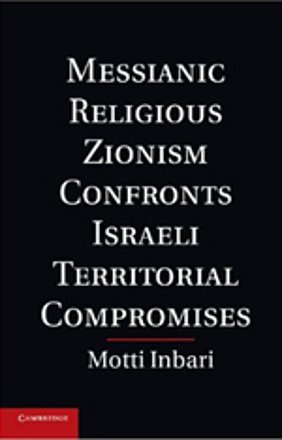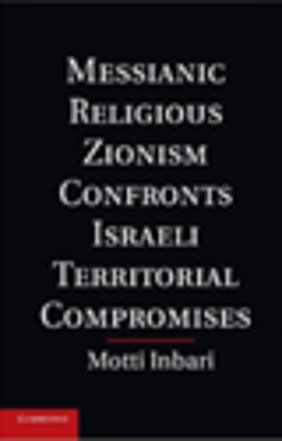Motti Inbari's book is an insightful introduction into messianic religious Zionists' (MRZ) evolving worldviews as they relate to political negotiations over land compromises. Inbari is particularly insightful in his discussion of the changes in approach since the Oslo period in the 1990s, and in my opinion this is the most important contribution of his book. He begins his book by situating the topic within literature dealing with cognitive dissonance (Leon Festinger’s thesis)[1] with religious fundamentalisms (Gabriel A. Almond, Scott R. Appleby, and Emmanuel Sivan); and with the advent of Gush Emunim and the emergence of the settlement movement (Gideon Aran and Gershom Gorenberg).
For primary source material, Inbari draws on the writings of MRZ rabbis and on the settlers' official monthly and weekly publications--Nekuda and Besheva respectively. These sources leave much unsaid, of course, but given the evolving relationship and tensions between the MRZ community and the State of Israel, inquiring into other primary sources within the MRZ community itself, sources that would give valuable and critical insight into the changing attitudes of its rabbinical leaders and their followers, would raise a red flag at best, outright hostility at worst. Thus, as usual, a more thorough historical analysis of the topic at hand awaits, maybe hopelessly and perhaps indefinitely, further access to insider sources.
At the heart of Inbari's argument is the MRZ's perceptions of the "sanctity [or non-sanctity] of secular government's authority" vis-à-vis territorial compromises. Inbari postulates that in the same way that the "feelings of persecution and siege" led the Muslim Brotherhood of Egypt and the Shi'a of Iran "into trends of revolution and violence," the decision of the Israeli government, starting with the Oslo process (1993), to uproot settlements has created a theological-religious crisis among the rabbinical leadership and followers of the MRZ. This crisis has led to a variety of responses, ranging from levels of qualified accommodation at one extreme (e.g., Rabbi Shlomo Aviner) to strands of militant violence at the other (e.g., Baruch Goldstein, 1994; Yigal Amir, 1995; and more recently Eden Natan-Zadeh and Asher Weissgan, 2005). In this maelstrom of opinions, followers within the MRZ can turn to “theocratic and revolutionary sentiments”; and coping with “messianic failure ... can push them [the followers] into political action.” Thus, “a movement can change course from accepting the authority of the state and working within the state’s institutions into working against the state as an independent entity” (p. 11, emphasis in original). According to Inbari, the radical fringe, which has always been present, has been and remains a minority, even though it has grown in recent decades.
The variety of opinions and approaches evolving within the MRZ community developed out of the thought of Rabbi Zvi Yehuda Kook and the brainchild of his thought: Gush Emunim (see chapter 1). In the realm of perceptions of the sanctity of government authority, Gush Emunim adopted Kook's "sanctification of statism"--what Inbari dubs the "statist approach"--which had led to Kook's belief that "redemption precedes repentance" (p. 29). According to Inbari, Gush Emunim's statist approach survived the defeat it suffered in 1982 in attempting to stop the eviction of settlers from Yamit in the northern Sinai peninsula resulting from the Egypt-Israel peace treaty of 1979 (see chapter 2). Gush Emunim's failed struggle for Yamit forced, however, the organization to confront the reality of territorial compromise for the first time.
The theological-religious crisis originated in the Oslo process that started in 1993 and culminated in the theological dilemmas brought to the fore by Israel’s Disengagement Plan (see chapter 6). Inbari covers the statist approach to the Oslo Accords in chapter 3. He concludes that all the approaches of the "statist mainstream" (i.e., the graduates of Mercaz Harav yeshiva) came to view redemption as “a protracted and complex process that does not necessarily follow a constant upward path" (p. 70). One approach, that of Rabbi Aviner, viewed the Oslo Accords as a test of faith; another, based on the ideas of Rabbi Yoel Bin Nun, believed that a compromise that might end the long-running conflict would not represent a failure or mark the end of the messianic process because any areas turned over to the Palestinians eventually would come back into Jewish possession on the realization of redemption. A third approach, developing from the messianic mysticism of Rabbi Zvi Tau, focused on intensifying educational efforts among the faithful.
Rabbi Yehudah Amital, who opposed violence and militant approaches (especially “the line adopted by supporters of Rabbi Avraham Yitzhak Kook’s philosophy” (p. 51)[2], announced as early as the Israeli military operation in southern Lebanon that he would support territorial compromises if it meant a lasting peace. In chapter 4, Inbari explores further how, in the face of messianic failure, the Oslo process fostered Amital’s “pragmatic interpretation of reality” and his shift toward a religious approach that demanded “morality and justice as the manifestation of the Jewish way of life” (pp. 72, 80).
But Amital’s approach was only one of several responses. The MRZ took a post-statist/post-Zionist turn as a result of the attempts to subvert the Oslo Accords. The “Jewish Leadership” movement--established by Motti Karpel (who provided an ideological base), Moshe Feiglin (who provided organizational/leadership skills), and Hillel Weiss (who provided public support)--embodied this post-Zionist approach and became an active and dynamic force that has increasingly influenced MRZ groups. The movement became involved in politics, first as an independent group but then infiltrating the Likud Party and mass campaigning on its behalf in the 2000s. Inbari offers this assessment of the “Jewish Leadership” movement:
This movement represents a hard response to cognitive dissonance. Their activities demonstrate the dynamics of messianic failure that pushes to radicalization. The attempt to change completely the political system and to transform it into a theocracy through political action is a manifestation of the fear of failure. Only time will tell how this movement will develop and what its influence will be.
Ariel Sharon’s Disengagement Plan and the negotiations over its implementation, which eventually led to withdrawal of settlements from the Gaza Strip in 2005 and set the precedent for further withdrawals from the West Bank under Ehud Olmert’s “convergence” plan (e.g., Amona in 2009), led to what Inbari calls “fundamentalism in crisis” (chapter 6). The debate within the MRZ rabbinical leadership created a rift and even a shift to the religious “right.” And, Inbari opines, the “core establishment” is now advocating the once marginalized post-statist and post-Zionist ideas discussed since the early 1980s. Statements of the rabbinical leadership included advocating a theocracy (sparked by disillusionment with the state); fighting the Disengagement Plan through education; arguing that implementation of the plan would reflect God’s will and therefore opposing it would be illegitimate; and withdrawing into Haredi passivism toward the state and its policies. In the face of the Disengagement Plan only a minority demonstrated against it and an even smaller minority resorted to violence in opposing eviction.
In chapter 7, Inbari covers the complex attitudes of MRZ rabbis toward violence and incitement (e.g., the Baruch Goldstein incident and Yitzhak Rabin’s assassination). Inbari describes as a disturbing development the increase in seeing political foes as evil and worthy of eradication. Inbari concludes that “once the opponent is described in such negative terms, and the general atmosphere is perceived to be one of distress and siege,” it should surprise no one when those who may be prone to violence interpret things in a militant way (p. 150).
Chapter 8 of Inbari’s book, dealing with American Christian fundamentalist responses to the “land for peace” solutions, comes across as an afterthought. Nevertheless, the topic is important and Inbari raises important issues worthy of further research and debate. Given the long-running U.S.-Israel alliance and the relationship between Christian interpretations of scriptural revelation and “end of days” apocalypticism, the topic is important and Inbari is correct in offering the comparison. The main criticism I have here is that although Inbari focuses on three “major evangelical thinkers” (Hal Lindsey, John Hagee, and Bill Koenig), he does not explain how their ideas and teachings have influenced followers--or how their followers have interpreted these ideas. To be sure, a deeper look into the Christian followers was not the emphasis of his book. Therefore, other scholars, and perhaps Inbari himself, certainly can expand on this topic.
Through his research, Inbari shows the large impact that an active, and in some cases more radicalized, minority can have on a given society, especially a society that has lived for so long, and understandably, with a siege mentality. Inbari wonders about what the future may bring: namely, in the face of further blows, will the MRZ community give heed to the restrained statist approach and remain “loyal and passive” vis-à-vis more evacuations of settlements in the West Bank (Judea and Samaria)? He posits that the trend set by the responses to the Disengagement Plan is “not encouraging” (p. 187).
I tend to agree with him on this point. I question the false and naïve assumption of some that the creation of a Palestinian state will bring a stable peace to the Middle East--that if we can only solve the Palestinian issue, whatever form that may take, peace will prevail. I entertain the possibility, maybe probability, that any solution, so perceived, will be nothing more than the next stage of the ongoing conflict. And pertinent to the topic at hand, any territorial compromises that are formalized in an agreement may incite increased acts of violence--terrorist acts--carried out by members of the MRZ community against the State of Israel, the Palestinian state, civilians, and/or government officials.
My view is pessimistic, I realize, and I eagerly listen to more positive outlooks whenever voiced. But unfortunately, my pessimism is not baseless; rather it is born of the fact that in times of crisis some too easily turn to religiously tinged apocalyptic (“end of days”) approaches that often can lead to radical activism and even to violent, sometimes terrorist, acts. In my desire for optimism, I hope that in the end good forces, in the form of both religious and secular institutions, can succeed in marginalizing supporters of such extremist approaches/acts and thus avert the tragic potentialities of “self-fulfilling prophecy.”
Inbari effectively synthesizes significant secondary sources with available primary sources to provide a stimulating and much-needed analysis of the changing attitudes of MRZ rabbis and followers toward violent responses to territorial compromises. The various reactions demonstrate how complex humans can be when faced with a cognitive dissonance caused by the clash of core beliefs with political reality.



